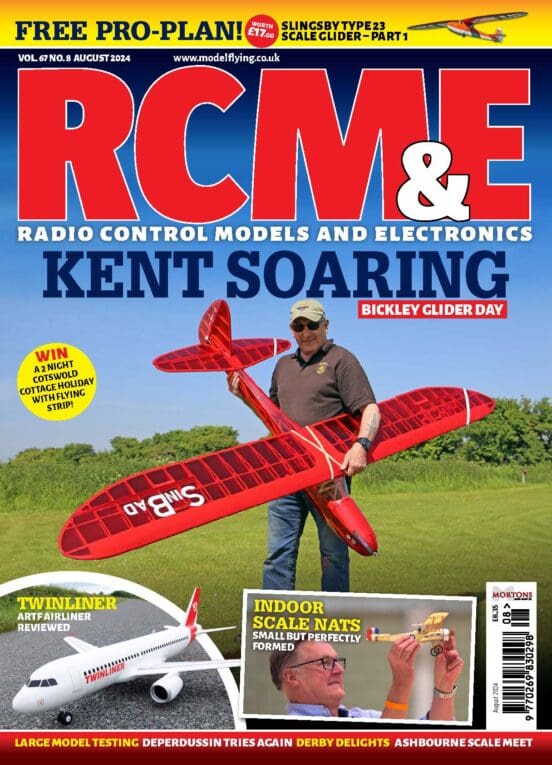In reviewing E-Flite's DHC-2 Beaver I was also asked to review the optional float set. Specifically E-flite's 25-size float set for which the Beaver is designed to accept thanks to hard-points built in to the fuselage structure.
Opening the box containing the floats, the first surprise is the sheer weight of them; they are extremely sturdy and by no means lightweight. Made from premium fibreglass and painted silver the entire assembly adds around 30oz (850g) to the weight of the model. This will naturally have an impact on the power to weight ratio and, as a result, the Power 32 motor is recommended for the Beaver in its float-equipped mode. Unfortunately, I had equipped mine with the Power 25 so I just had to hope this would be enough.
Enjoy more RCM&E Magazine reading every month.
Click here to subscribe & save.
ASSEMBLY
The float kit is flawed in places in the same way as the model, in that you get a mish-mash of parts and screws but really have to forage about for the right bits you need to complete the job. For example, you get a spot-welded piano wire u/c set and one that can be made up from separate parts; but there aren’t enough grub screws to assemble it. There is also a lack of the main type of screw you need to attach the floats to the sturdy plastic mounting blocks, so you’ll have to hope you have some similar. And very oddly, you get two completely different types of mounting straps (saddle clamps) for the fixture to the fuselage, one is nylon and the other is brass! I can only assume this is to accomodate other models in the E-flite range.

The set-up itself fits quite quickly and easily and is very strong when in situ but the float rudder linkage, working from the aero rudder servo in unison, involves a lengthy piece of Bowden type snake that has to bend through 180 degrees to work an already stiff brass rudder. The result is an extremely clumsy and stiff linkage that takes quite a lot of setting up, reaming and oiling to work anywhere near as well as you would accept. However with a little perseverance you can get things sorted and after blanking off the gaps where the land undercarriage slotted into place (to avoid water ingress to the radio bay) the float-equipped Beaver was ready for the off. One thing the floats do help with is the C of G, and half of the lead I had to fit in the nose (see Beaver review) could be removed.
FLOATING AWAY…
Never having flown a float plane before (only a selection of flying boats) this was to be new experience but the float rudder turned out to be very effective at keeping the model straight and, after a considerable run, the model eased into the air. The extra weight and drag of the floats was immediately noticeable, and the first turn had to be made quite gently, but once underway the model was completely manageable despite a rather heavy feel.
As a result, I intended to keep the model moving – but the ESC gave out after half a circuit and left me heading downwind, deadstick and above land! It is moments like this that are a reviewer’s nightmare, but to its credit the float-equipped Beaver has an incredibly stable and flat glide and despite not thinking I would have sufficient height, the model was eased gently round short finals and landed, albeit with a bit of a splash, back on the water.
Subsequent flights have shown that whilst a little underpowered with the Power 25 set-up, the Beaver does actually fly very well indeed with the floats fitted, possibly due to the lower polar moment of inertia or perhaps simply the aerodynamics of the floats themselves which whilst rather heavy, appear to be very well designed.

With hindsight I would recommend that if you buy a Beaver and ever intend to fit floats, it would without doubt be better going for the more powerful Power 32 motor from the outset; the extra power will make the wheel-equipped model all the more aerobatic, whilst providing that extra bit of grunt you’d prefer for a rise off water and the associated climbout.
Landing on floats takes a little more practice than you would think, even a landing that you would consider a 'greaser' on grass or tarmac can result in a big water-splash and the model slows down very quickly after contact with the water. But taxi-ing benefits from the airborne and water rudders and unlike a flying boat that always seems to want to dig a wing in the water, the seaplane version of the Beaver is extremely stable and completely controllable unless the wind is fairly strong.
Certainly for the extra outlay, and especially if you have a stretch of water nearby, the float kit at less than £50 adds a whole new dimension to flying the E-Flite Beaver and can be highly recommended – it’s a whole lot of fun!
See www.horizonhobby.co.uk for spec' details of the float set.





